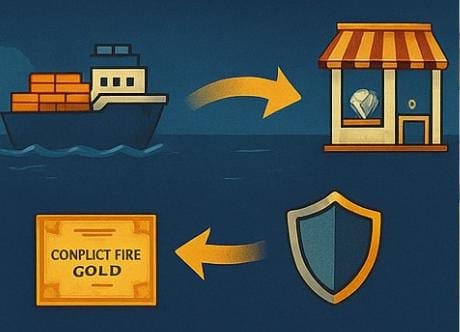
The Gold Supply Chain: From Earth’s Depths to the Jewelry Store
Gold has fascinated humanity for thousands of years — a symbol of wealth, beauty, and power. But behind the gleam of a gold ring lies a long, complex journey involving miners, refineries, manufacturers, and retailers across the globe. Understanding this supply chain not only sheds light on the value of gold but also on the ethical and environmental challenges embedded within it.
- Mining: Where the Journey Begins
Gold’s journey starts deep beneath the earth’s surface. Mining operations extract gold ore through three primary methods:
Open-pit mining – Large-scale excavation from surface deposits.
Underground mining – Tunnels and shafts to reach deep ore bodies.
Alluvial mining – Collecting gold from riverbeds and sediments.
In Indonesia, major gold-producing regions include Papua, Kalimantan, and Sulawesi. While mining fuels economic growth, it also brings significant environmental risks, such as deforestation, soil erosion, and disruption of local ecosystems.
- Refining: Turning Ore into Pure Gold
Once extracted, gold ore is processed to isolate the precious metal:
Crushing the ore into fine particles.
Mixing it with chemicals such as cyanide or mercury to separate gold from other minerals.
Extracting and melting it into gold bars or ingots.
However, these methods pose serious environmental challenges, particularly toxic waste management and water pollution. Increasingly, there is a push toward cleaner, mercury-free refining technologies.
- From Mines to Global Markets
Refined gold often travels far before becoming jewelry. The global distribution chain typically includes:
International refineries for further purification.
Jewelry manufacturers who craft designs for different markets.
Retailers selling the finished products.
Gold can pass through multiple countries in this process, reflecting its status as a highly traded global commodity.
- Transparency, Ethics, and Certification
The gold industry faces persistent concerns over unethical sourcing. The Conflict-Free Gold Standard, established by the World Gold Council, ensures that gold does not originate from mines financing armed conflicts or human rights abuses.
Despite such initiatives, illegal mining and hidden supply chains remain serious challenges, making transparency a top priority for responsible gold businesses and conscious consumers alike.
- Beyond the Shine: Understanding Gold’s True Cost
Gold is more than a decorative asset. It carries the weight of geological history, human labor, and sometimes, environmental damage. By tracing its supply chain, consumers can make informed choices and support responsible sourcing practices.
Final Thought
A gold necklace or wedding ring may sparkle under the lights of a boutique, but its story begins in the dark veins of the earth. It passes through the hands of miners, engineers, artisans, and traders — each step shaping its value and meaning. Knowing this journey not only deepens our appreciation of gold but also reminds us of the responsibility we bear in sustaining its future.
